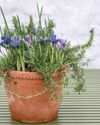
My encounters with The Queen over the years were many and varied: we planted a palm tree together to celebrate the centenary of the opening to the public of Osborne House on the Isle of Wight once the home of Queen Victoria, and given to the nation after her death by King Edward VII. I say 'we' and, indeed, Her Majesty did throw a couple of spadefuls of earth in the direction of the plant, but she was then very happy to hand over the implement and let me complete the operation, smiling wryly and indicating with a raise of her arm my expertise to the surrounding spectators, who broke into a round of applause.
Our very first encounter was slightly more nerve-wracking.
I had designed a 'Country Kitchen Garden' at the RHS Chelsea Flower Show in 1985 and on the day of the royal visit - the Monday of Chelsea week - I stood nervously by my plot wearing, for some reason I now cannot fathom, a maroon- and black-striped blazer I had found in a junk shop, a white shirt, yellow bow tie and white trousers. I thought it unlikely that Her Majesty would be shown my modest garden, replete with flower borders, a miniature orchard underplanted with wildflowers, a rill fed by water spilling out of an old village pump and vegetables in neat rows either side of a brick path. I was mistaken. Just as I assumed she would be whisked past my creation, the president of the society ushered The Queen across the wide expanse of tarmac and told her my name. For the first time I found myself on the receiving end of that famous smile and led Her Majesty forward to examine my handiwork. She seemed genuinely interested and mentioned my "clipped ilex".
Surprise number one: The Queen used the Latin name for holly.
This story is from the November 2022 edition of Gardeners World.
Start your 7-day Magzter GOLD free trial to access thousands of curated premium stories, and 9,000+ magazines and newspapers.
Already a subscriber ? Sign In
This story is from the November 2022 edition of Gardeners World.
Start your 7-day Magzter GOLD free trial to access thousands of curated premium stories, and 9,000+ magazines and newspapers.
Already a subscriber? Sign In

Tales from Titchmarsh
Tending the land is a rewarding if undervalued career, and it's also the best way to safeguard our future on this planet 'Same old, same old...' is a phrase that sends a shiver down my spine. Friends who have hoed the same furrow (pardon the gardening analogy) year after year in a job that pays the rent but which they do not like have my deepest sympathy.

Container of the month
Mark fresh beginnings with a hit of colour, combining bright evergreens and early risers

Boost your wellness the natural way
Gardening is good for you! Six inspiring experts reveal how getting your hands into soil, growing beneficial plants and connecting with nature can transform all aspects of your health.

Potting on a winter show PART 2
Nick Bailey banishes January blues with a sophisticated container display that's guaranteed to lift the spirits

Winter scents
Fragrant flowers can help lift the spirits on cold winter days. Monty shares his favourite plants to fill the garden with olfactory joy

Growing THE GOOD LIFE
If you've always wanted your own mini farm, let urban smallholder Sara Ward show you how

Arit's 7 deadly sins
Discover Arit Anderson's guilty gardening secrets and how you can turn your own sins into wins

Garden globetrotting
Desert Botanical Garden, Phoenix Garden globetrotting Fancy a new look for your plot or just want to try something different? Our new series about gardens around the world could be just the ticket. This month, Matt Collins reveals what captured his heart in Arizona

10 nature-led ways to feed birds
Want to give wild birds a natural boost this winter? Kate Bradbury explains how to attract a wide diversity of birds to forage within your garden and why this is so beneficial

A new plot for tasty crops
Taking on a new allotment needn't be hard work. By simply following a few easy tips you can have bumper crops in no time, just like Alessandro Vitale